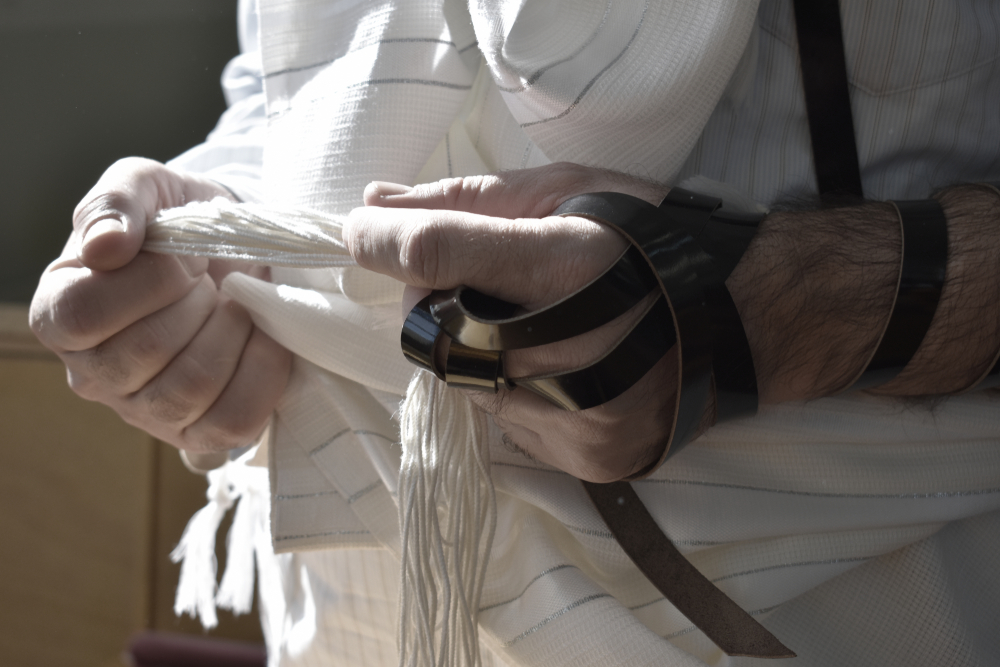THE ART OF WEARING TZITZIT

click shlach 2021 final for download
THE ART OF WEARING TZITZIT
Parashat Shelach
The Maggid from Dubno would tell the following story. A man walking in the forest noticed a small house that seemed vacant, but there was a voice of an old man, crying, inside. He hurried over to the house to make sure that everyone was okay, but the front door, that had a mezuza on it, was locked. He knocked, but no answer. He banged hard on the door, as he could not ignore the sound. He moved over to the window, broke it open and climbed into the house, calling out, asking, if everyone was okay. But the cries just continued. This man continued to search throughout the small house, that seemed a bit messy, as if the owner had gone on some sort of trip. He followed the sound of the cries of that old man, all the way to the bedroom closet. He opened the closet,… and there was no one inside! There was just a Tallit, a crying Tallit!
He asked the Tallit, why are you crying? The Tallit said, “The owner went on a trip and took everything he needed: his passport, credit card, clothes and sunglasses. But he forgot me! He even came back a second time, because he forgot his cellphone charger, but he forgot me, again!” The man who came to help tried to console the Tallit, that it was not intentional, or other consolations. But nothing calmed the Tallit – until the Tallit said, “There is one thing that will console me! I know that there will be a trip, a long journey, on which my owner will not be able to take anything else he owns… just me. No phone, no credit card, no sunglasses, no clothing… just me. When he dies, when he goes to the next world, he will be buried with me, with his Tallit, and nothing else, because only one who wears Tzitzit can merit to see G-d. (Menachot 43b) And, up in Heaven, in the Heavenly court, they will ask me to testify, about my owner’s adherence to the 613.”
Tzitzit is numerical value of 600. There are 8 strings, and five knots, a total of 613. Every minute you wear Tzitzit, (wool for Sefardic), is equal to performing all the 613 mitzvoth. As Tzitzit is the reminder of the 613 that we are supposed to do for Him and is the rope that He throws to us, to grab onto and save us spiritually from the physical world we are drowning in.
The Tzitzit is given that name, after the word, הִנֵּה־זֶ֤ה עוֹמֵד֙ אַחַ֣ר כָּתְלֵ֔נוּ מַשְׁגִּ֙יחַ֙ מִן־הַֽחַלֹּנ֔וֹת מֵצִ֖יץ מִן־הַֽחֲרַכִּֽים. Behold, This one, he is standing behind our wall, watching from the window, peeking from the cracks. ציצית, Tzizit, means “double peeking”: G-d is peeking at us, watching over us, to see how much spiritually we infuse into our physical lives. While we are also peeking out at G-d, connecting spiritual “strings” to our physical world and lives.
I remember, 24 years ago, at the onset of the summer between 9th and 10th grade, playing baseball, I swung the bat too far and I pulled my left leg out of the socket, something I never thought could happen. The doctor did not let me go to summer sleep-away camp that year, as I needed crutches; and, no running for a month and a half. At the end of the time off running, I was learning Mishna Brurah, that although there is no mitzvah to wear Tzizit at night, still, it should be worn for protection. I wondered what type of protection tzitzit can provide for me; after all, they are only strings!
That night, I walked down the poorly lit, no sidewalk, Washington Drive, from my house in Deal, N.J., towards the Deal Shul, to catch the 10 p.m. Arvit. It was a beautiful Deal summer night, and my leg was feeling better, and I started running, and it felt good. I heard a car coming from behind me, but I was sure that driver saw me. Suddenly, the car screeched to a stop right next to me! The window rolled down, and it was two of my older brother’s friends, calling out to me: “Are you crazy?! We were going 60 miles an hour, right behind you into your back, and we could not see you at all; you are wearing a black jacket, black pants, black socks and shoes and a black yarmulke… Get in the car; we’ll take you to shul!” I was frightened, and I asked them what they actually saw on me that caused them not to run me over: “As we got real close, we suddenly saw white strings, jumping up and down!” I usually keep my Tzitzit strings in my pants, but because I was running, they must have popped out, and served as reflectors!
Tzitzit is your protection from any danger, physical or spiritual. For this reason, one should not take off his Tallit until after Aleinu, so that the prosecuting angels can’t interrupt any part of your prayer. And this is why, when a person is buried, or when a person sleeps, he wears Tzitzit that protect him from any prosecuting angels.
A person is not supposed to show Tzizit strings in the Jewish cemetery, because it causes the dead people there to be jealous. They do not mind, they are not jealous, if you come with a fancy car, fancy clothes, or a fancy wife wearing fancy jewelry. That doesn’t make them jealous, in the slightest. But tzitzit strings!!!! The jealousy is too strong for the dead to handle!
Its only here, in this 120-year trip, that you can connect with a spiritual connection to everything physical. It is only here that you can have a special, unique connection with G-d, where He will protect you, physically and spiritually, in the darkest of places.
The Torah commands us to wear blue Techelet strings when we have the Chilazon fish whose blood we use as the blue dye. Why? So that when we look at the blue string, it will remind us of the blue sea, the blue sky, and G-d’s throne. But why do we need to look at a blue string at all? Why can’t we just look at the blue sky and remind ourselves of G-d?
The answer is because what a person sees, the way a person perceives, is influenced by his passions and desires. וְלֹֽא־תָת֜וּרוּ אַחֲרֵ֤י לְבַבְכֶם֙ וְאַחֲרֵ֣י עֵֽינֵיכֶ֔ם Do not stray after your hearts, and after your eyes. Why heart, and then eyes? Don’t we interpret with our hearts what we see with our eyes? The answer is, NO!!! We interpret what we see with our eyes, with how we feel with our hearts. The Techelet strings are to remind you about your Tachlit, your purpose, and when you focus on your purpose, you can ignore your passions. If you would just look at the sky, alone, you would not see the same sky as the one who is thinking about his life’s purpose!
Tzizit has so many segulot, including having children, specifically boys, that keep mitzvot. וְעָשׂ֨וּ לָהֶ֥ם צִיצִ֛ת עַל־כַּנְפֵ֥י בִגְדֵיהֶ֖ם לְדֹרֹתָ֑ם , for their generations. This is why the minhag is for the bride to buy her husband a Tallit for a present for the wedding, and when a girl is not finding her shidduch, there is a segula for her to buy a Tallit for her future husband.
When Mashiach comes, each Jew who was particular to wear Tzitzit will merit having 2,800 gentiles who will beg to be his slaves. (Shabbat 32b) What is a person going to do with so many slaves? I don’t know. You can ask Eliyahu Hanavi soon. But one thing for sure, never feel embarrassed from the gentile, now, when you wear your tzitzit. Because, when you wear Tzitzit like a proud Jew, you are living for a purpose, G-d is watching over you, and protecting you, and one day, it will all become clear to the world.

